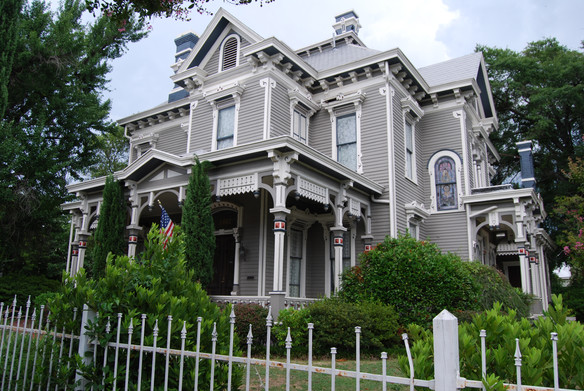Great Town Houses
- Historic Columbus
- May 30, 2024
- 6 min read
SOURCE: Historic Preservation in Columbus, Georgia. An Official Publication of the Columbus Area Bicentennial Committee. April 1976. The booklet was prepared for the Committee through the cooperative efforts of the Lower Chattahoochee Area Planning and Development Commission, the Columbus Museum of Arts and Crafts, and the Historic Columbus Foundation.

The historic townhouses in Columbus can be divided into two broad categories unrelated to architectural style: the small, clapboard townhouses found in the Columbus Historic District and the much larger uptown mansions which were often under masonry construction. In distinguishing the two, the latter will be referred to as Great Town Houses.
A number of these houses have been lost because their proximity to the main downtown business section made them extremely vulnerable. The Fontaine House (top image), which stood on Front Avenue at Eleventh Street, was torn down as early as the 1930s to make room for a supermarket and parking lot. The Martin J. Crawford House (left), which stood on Thirteenth Street between Second and Third Avenue, was demolished and replaced by an automobile sales lot. Several others that have been lost are the Pease House (908 Broadway - middle), the Dragon House (SW Corner 2nd Avenue and 14th Street - right), the Bethune House (703 Broadway, aka Fontaine Pennell House - below), and the Strupper House (803 Broadway - not pictured). They are just a few examples of the many fine old Columbus houses that are no more. Most of those that survive are located above Twelfth Street in an area known as High Up-town.

The Greek Revival style was a popular style of domestic architecture in the Piedmont of Georgia, one of even cult proportions, and that style, in its pure form, was used many times in the Columbus building. Regretfully, the city has only a few remaining examples of this style of townhouse.
Among the several examples of this classic style that remain is the house that Dr. Samuel A. Billings built in 1856 at 303 Twelfth Street. Known for many years as the Swift-Kyle House (below), it employs an unusual plan, consisting of three rooms on each floor, connected by a t-shaped hall, with the drawing room forming a bay. Eleven columns and two front doors form the perfectly balanced Greek Revival House.
The house was purchased in 1864 by George Parker Swift and was occupied by the descendants of that family until 1956. The house is still owned by the family and is leased to the Columbus Travel Bureau, Inc. It is one of the city's best examples of historic preservation, rather than restoration, and was listed on the National Register in 1913.

The Lion House, deriving its name from two cast-iron lions that guard its front door against either side of steep front steps, was designed by Stephen Button of Philadelphia. While this antebellum house at 1316 Third Avenue, is classified as Greek Revival, many of its decorative details are of Egyptian influence.
The environment of the Lion House has changed over the years. It is now completely surrounded by commercial structures and parking lots, which weakens its chances the National gut the house, and there is hope that it will remain with us.

Neighboring antebellum houses on upper Second Avenue are totally different in style, reflecting the individuality of their builders. The house, built circa 1850 by James A. Chapman, has been identified with the Illges family since 1877. Known as the Illges House (pictured above), this Roman Revival house has a stuccoed facade with six large Corinthian columns. Its detailing and proportions reveal that its builder was influenced by the Classical Revival as well as the increasingly fashionable Italianate style. The Illges House, listed in the National Register in 1973, was given to the Historic Columbus Foundation by Mrs. James W. Woodruff, Sr., nee Ethel Illges in memory of her husband and her parents.

The Rankin House (pictured below), 1440 Second Avenue, was built by James Rankin, a planter and owner of the Rankin Hotel who came to Columbus from Scotland. Construction began before the Civil War but was not completed until after the War.
The brick house is constructed in the style of the Second French Empire and is noted for the exquisite iron grillwork of its veranda and flying balcony, the pattern of which features birds nibbling at baskets of fruit. Wide heart of pine floorboards, generous windowsills, hand-carved cornices, and door frames, and a solid walnut double staircase, rising to a landing from a spacious center hall, combine to produce a dwelling of exquisite craft.
The Rankin House, given to the Historic Columbus Foundation in memory of James Waldo Woodruff, Sr., has been restored as an 1850-1870 historic house museum. Its restoration and the furnishing of the downstairs rooms were accomplished through the cooperation of the Foundation, the Junior League of Columbus, the Colonial Dames, and many interested individuals. The Rankin House was listed on the National Register in 1972. A walled garden given in memory of Charlie Frank Williams by Mrs. Williams enhances the property.

The Phillip T. Schley House (pictured below) is a small townhouse when compared to its neighbors, the Rankin and Illges Houses. However, this brick Greek Revival cottage with Federal details is beautifully wrought with dentil moldings along its cornices, a one bay single story portico supported by two fluted Ionic columns, and a doorway complete with sidelights and a fanlight. The house was built in the late 1830s as a raised cottage and was located at the intersection of what is now Second Avenue and Eleventh Street. About 1855 it was dismantled and reassembled at its present location 1445 Second Avenue. As the new site sloped to the rear, the house lost its raised appear the front. The house has been beautifully restored as a private residence.
During the Civil War, the house was occupied by the family of Mr. & Mrs. George H. Peabody, whose son, George Foster Pea-body, grew up to become a noted financier and philanthropist. Later the house became the home of descendants of Maj. James H. Warner who was the superior officer at the Columbus Iron Works and designer of the Gunboat Muscogee. Placed on the National Register in 1970 the house is often referred to as the Schley-Peabody-Warner House.

The Robert Alexander House, referred to locally as the McGeehee-Woodall-Nilan House, 1543 Second Avenue (pictured below and now located in the 1400 block of Second Avenue), was built about 1845. This imposing raised cottage, in the Greek Revival style, is noted for its stately proportions, its classical one-bay portico, supported by four Doric columns spaced two together, and for the deep rich color of its brick. As a raised cottage the main living rooms are located on the second floor, the piano nobile, accessible by way of wide steps rising from the street level to the portico. Four rooms, split by a central hall, are located on each of two floors. The house is owned by the descendants of the Woodall family and is used as the headquarters of the Senior Citizens Organization. The house was listed on the National Register in 1972.

Another noted brick structure, of mansion proportions, is located at 1445 Fourth Avenue (pictured below and now the site of Taco Bell). This house, perhaps the city's only example of the Tuscan style, is for sale in a commercially zoned area. How long this house will remain on the list of surviving historic houses is unanswerable, but it certainly has a precarious future.

Two other townhouses of major significance, the Bullard-Hart House, at 1408 Third Avenue, and the Bullock House, at 1402 2nd Avenue, are wooden structures.
The Bullard-Hart House (now Bullard-Hart-Sampson - below on left), built for Dr. and Mrs. Williams Louis Bullard is one of the French Empire styles and contains exceedingly sophisticated interior decorations of tooled leather and carved wood. The house was designed by the architectural firm L.E. Thornton and Company of New York. The interior decorations were designed and executed by another New York firm, the Le and intricate Rolle Company. Because of its elaborate detail, the construction of the Bullard-Hart House took almost four years to complete - from 1887 until 1890.
Built in approximately 1898, the Bullock House (now Garrett-Bullock - above on right) is one of the most ornate Victorian houses in the Southeast and is characterized by its multiplicity of curved brackets and stained-glass windows.
The Mott House located a few blocks West of High Uptown, on the banks of the Chattahoochee River is the city's only remaining example of a large antebellum riverfront townhouse. The three-story Georgian house was built, circa 1840, for Mrs. James S. Calhoun. The house was sold in 1849 to Daniel Griffin, a young Irish civil engineer. Mr. Griffin changed the original roof line, adding a mansard roof capped by a cupola and ornamental ironwork. Mr. Griffin also built elaborate gardens which extended to the river's edge.
The house was sold to Col. Randolph Mott in 1856 and remained in his family until 1881 when it was sold to the Muscogee Manufacturing Company. The house was purchased by Fieldcrest Mills around 1965 and presently serves as the company's local office. The elaborate gardens that once surrounded the house no longer exist.
Several blocks along upper Second and Third Avenues contain most of the remaining Great Town Houses of Columbus. While certain of these structures are being preserved, others are not. The environment of the area has deteriorated. Protective laws and Historic District status are needed immediately to help restore and preserve this small but valuable historic area of the city.


















NOL Card is a smart contactless card for paying fares across Dubai. It enables users to travel efficiently without carrying cash. Its flexibility, fast recharging, and support for multiple transport services make it ideal for everyday commutes.
Try something new with STLTH pod flavours like Blue Raspberry, Peach, and Banana Ice. See what’s trending. disposable vape Find your next all-day vape with our STLTH pod flavour breakdown. Sweet, bold, and cool options available.
The service often referred to as a "Partner Night Call Girl" typically encompasses an extended engagement where a client secures the companionship and intimate services of an individual for a significant duration, frequently spanning an entire evening or night. This arrangement moves beyond a brief encounter, aiming to fulfill a broader spectrum of needs that can include dining, conversation, social interaction, and the provision of agreed-upon physical intimacy, all within a professional, transactional framework. Clients who seek such services often desire not only physical gratification but also a temporary sense of connection or partnership, valuing the comprehensive experience offered during the contracted period. Ultimately, this specific form of engagement underscores the complex interplay between commercial service provision and the human…
The demand for Chhatarpur Escort is growing for all the right reasons. These gorgeous ladies offer luxury, class, and complete discretion. Whether you need someone for a romantic dinner or a private escape, they’re ready to deliver exceptional service. Don't miss the chance to experience something extraordinary with the top models in the area.
Experience unmatched passion and pleasure with the exhilarating Call Girl in Delhi. These beauties are articulate, sensuous, and love to please. Whether you want to be romanced or just have some crazy fun, the Call Girls Service Delhi will assure your complete satisfaction.